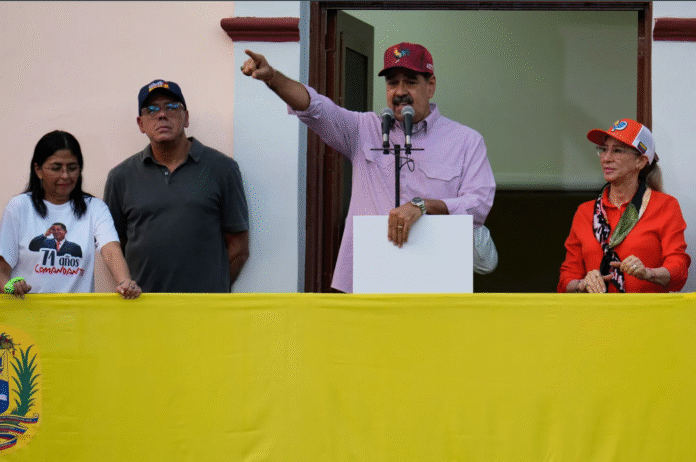Venezuela Militia Mobilisation and Rising Tensions with the US
Venezuela militia mobilisation has become the latest chapter in the growing confrontation between President Nicolás Maduro and the United States. In a bold televised announcement, Maduro declared that his government would activate more than 4.5 million militia fighters to counter what he described as fresh “extravagant” and “outlandish” threats from Washington.
The escalation comes after the US government doubled its bounty on Maduro’s arrest to $50 million while simultaneously deploying three guided-missile destroyers to the southern Caribbean. The White House accuses Maduro of running a powerful cocaine trafficking network known as the Cartel de los Soles, an allegation Caracas strongly denies.
Maduro’s Call for Venezuela Militia Mobilisation
In his address, Maduro stated:
“This week, I will activate a special plan with more than 4.5 million militiamen to ensure coverage of the entire national territory – militias that are prepared, activated and armed.”
The Venezuela militia mobilisation plan is designed to expand coverage of rural and urban regions, ensuring that the government maintains a visible presence across the nation.
The Venezuelan militia was originally founded by former President Hugo Chávez as a “citizen defense force.” While official numbers claim nearly five million members, independent analysts argue the figure is exaggerated and could be significantly lower. Considering Venezuela’s total population of around 30 million, this militia represents a sizeable portion of the country’s social fabric.

US Pressure Mounts on Maduro
The new confrontation follows years of tension between Caracas and Washington. The Trump administration has consistently refused to recognize Maduro’s election victories, branding them fraudulent. The US has imposed strict sanctions on Venezuelan oil, banking, and military sectors, crippling the country’s economy.
Now, with a $50 million bounty and fresh naval deployments, the US is signaling tougher enforcement against Maduro’s alleged links to international drug cartels. According to reports, USS Gravely, USS Jason Dunham, and USS Sampson will soon be positioned near Venezuela’s coast, accompanied by roughly 4,000 sailors and Marines.
Venezuelan Interior Minister Diosdado Cabello dismissed the moves, declaring:
“We are also deployed throughout the Caribbean … in our sea, our property, Venezuelan territory.”
Venezuela Militia Mobilisation: Sovereignty and Survival
Maduro’s strategy appears twofold: deter US aggression while consolidating loyalty at home. By arming militia units with “rifles and missiles,” the Venezuelan leader is betting on grassroots mobilization to safeguard his rule.
This mobilisation also sends a political message, Maduro wants to project strength and sovereignty, countering claims of weakness or illegitimacy. He urged his supporters, especially workers and peasants, to expand their participation in the militias, framing it as a patriotic duty.

International Reactions to Venezuela Militia Mobilisation
Despite growing US hostility, Maduro still garners some backing abroad.
-
Mexico’s President Claudia Sheinbaum rejected US allegations linking Maduro to Mexico’s Sinaloa Cartel, stating there was “no evidence” to support such claims.
-
Russia, China, and Iran have historically supported Venezuela diplomatically and economically, often criticizing US sanctions as violations of sovereignty.
-
Human rights groups warn that further militarization could escalate violence and worsen humanitarian conditions for ordinary Venezuelans.
The international divide highlights how Venezuela militia mobilisation is not merely a domestic policy but a flashpoint in global geopolitics.
A History of Militia in Venezuela
The concept of a national militia is not new to Venezuela. Under Chávez, militias were formed to give ordinary citizens a role in defending the “Bolivarian Revolution.” The force was meant to supplement the regular armed forces while also cultivating political loyalty.
However, critics argue these militias have been used as instruments of political control rather than national defense. International observers fear that by arming millions, the risk of civil unrest, human rights violations, and internal conflict increases dramatically.
What Venezuela Militia Mobilisation Means for the Future
The announcement signals that Maduro is unlikely to back down under US pressure. Instead, he is doubling down on a strategy of domestic militarization, nationalist rhetoric, and external alliances.
If the US continues to escalate, Venezuela could see:
-
Increased militarization of urban areas.
-
Heightened risks of armed clashes near its coast.
-
Greater regional polarization between pro- and anti-Maduro governments.
-
Severe economic fallout as sanctions deepen.
At the same time, ordinary Venezuelans already grappling with inflation, food shortages, and migration crises, may face worsening living conditions.
Conclusion: Venezuela Militia Mobilisation and the Road Ahead
Venezuela militia mobilisation represents more than just a military maneuver; it is a political survival tactic. By activating millions of militia fighters, Maduro is attempting to project power, deter external threats, and rally domestic support.
Whether this gamble strengthens his position or pushes Venezuela closer to crisis remains to be seen. What is clear is that the struggle between Caracas and Washington is entering an even more volatile phase, with potential global repercussions.
For more updates on Latin American geopolitics, explore our World News section and stay connected with the latest developments.

